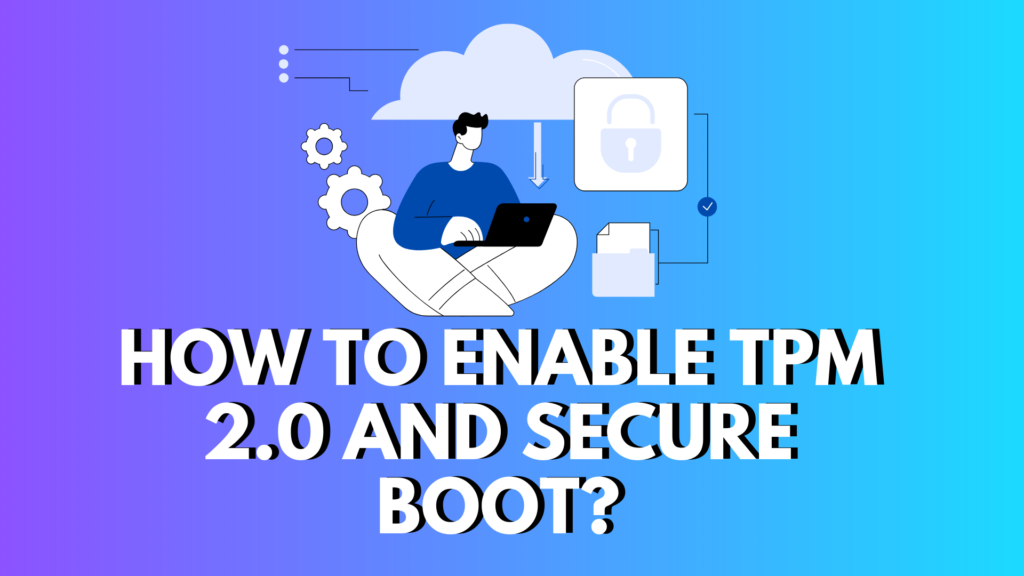
In today’s fast-paced digital world, safeguarding your computer from malicious attacks is more crucial than ever. Modern operating systems—especially Windows 11—demand enhanced security measures to protect user data and maintain system integrity.
In this guide, we’ll explore three critical components of PC security: TPM 2.0, Secure Boot, and BIOS Updates. Whether you’re running Windows 10 or Windows 11, understanding and implementing these features can significantly boost your computer’s security.
enable tpm 2.0
enable tpm 2.0 gigabyte bios
enable tpm 2.0 in bios
enable tpm 2.0 msi bios
enable tpm 2.0 msi click bios 5
enable tpm 2.0 uefi bios
enable tpm and secure boot
enable tpm in uefi bios
enable tpm msi click bios 5
enable tpm on asrock motherboard
enable tpm uefi bios
1. What Is TPM 2.0 and Secure Boot?
TPM 2.0: The Hardware Security Backbone
The Trusted Platform Module (TPM) 2.0 is a dedicated microcontroller designed to secure hardware by integrating cryptographic keys into your system. It performs several essential functions:
- System Integrity: Measures and verifies the boot process to ensure no tampering has occurred.
- Disk Encryption: Safeguards encryption keys used by tools like BitLocker.
- Authentication: Enhances identity protection for services like Windows Hello.
Secure Boot: Ensuring a Trusted Start-Up
Secure Boot is a UEFI firmware feature that ensures your PC boots only with software that is trusted by the manufacturer. It verifies digital signatures during the boot process, preventing malware from hijacking the startup sequence.
2. TPM 2.0 and Secure Boot in Windows 10 & Windows 11
What Is TPM 2.0 and Secure Boot Windows 11?
Windows 11 requires both TPM 2.0 and Secure Boot to be enabled. This combination ensures a higher security standard by:
- Preventing Unauthorized Software: Only trusted software loads during startup.
- Securing Sensitive Data: TPM 2.0 helps safeguard encryption keys and system credentials.
What Is TPM 2.0 and Secure Boot Windows 10?
While Windows 10 supports TPM 2.0 and Secure Boot as optional features, enabling them can still significantly enhance your system’s security. Users benefit from improved protection against firmware-level attacks and unauthorized access.
enable tpm in uefi bios
enable tpm 2.0
enable tpm 2.0 uefi bios
enable tpm and secure boot
enable tpm in uefi bios
enable tpm msi click bios 5
enable tpm on asrock motherboard
how to enable tpm 2.0 in bios asrock
enable tpm uefi bios
bios msi secure boot
3. Enabling Secure Boot and TPM 2.0: Step-by-Step Guides
How to Enable Secure Boot on Windows 10 & Windows 11
- Access UEFI Firmware Settings:
- Go to Settings > Update & Security > Recovery.
- Under Advanced Startup, click Restart now.
- After restarting, select Troubleshoot > Advanced options > UEFI Firmware Settings > Restart.
- Enable Secure Boot:
- In the UEFI menu, find the Boot or Security tab.
- Locate the Secure Boot option and set it to Enabled.
- Save changes and exit.
How to Enable TPM 2.0 in BIOS / How to Turn On TPM in BIOS
- Enter BIOS/UEFI Settings:
- Restart your PC and press the designated key during boot (commonly F2, F10, Delete, or Esc).
- Locate the TPM Setting:
- Look under the Security or Advanced tab.
- Find the option labeled “TPM,” “PTT” (Intel Platform Trust Technology), or “fTPM” (for AMD systems) and enable it.
- Save and Exit:
- Save your changes and restart your PC.
How to Enable TPM 2.0 Windows 11
For Windows 11, enabling TPM is essential. Follow the same BIOS steps as above, ensuring that TPM is enabled before installing or upgrading to Windows 11.
4. Updating Your BIOS: Keeping Your System Up-to-Date
Why Update the BIOS?
Your computer’s BIOS (Basic Input/Output System) initializes hardware components and plays a vital role in system stability. Updating your BIOS:
- Enhances system compatibility.
- Fixes known bugs and vulnerabilities.
- Improves hardware support and performance.
General Steps to Update Your BIOS
- Identify Your Current BIOS Version:
- Press
Windows + R, typemsinfo32, and hit Enter. - Look for the “BIOS Version/Date” entry.
- Press
- Download the Appropriate Update (TPM 2.0 Download Not Needed Separately):
- Visit your manufacturer’s official website.
- Search for BIOS updates by entering your specific model number.
- Prepare a Bootable USB Drive:
- Format a USB drive to FAT32.
- Copy the BIOS update file to the root directory.
- Perform the Update:
- Reboot your PC and access BIOS/UEFI settings.
- Use the manufacturer’s BIOS update utility (e.g., EZ Flash, M-Flash, or Q-Flash) to select and install the update.
- Follow on-screen instructions carefully—do not interrupt the process.
Manufacturer-Specific BIOS Update Resources
- ASUS: Use the EZ Flash utility. More info on the ASUS support page.
- MSI: Use the M-Flash utility. Visit the MSI BIOS Update page.
- Gigabyte: Use Q-Flash. Check the Gigabyte support page.
- Dell: BIOS updates are available directly from Windows. Visit the Dell support page.
- HP: Use HP Support Assistant. More details on the HP support page.
5. Frequently Asked Questions on TPM 2.0 and Secure Boot
Do I Need TPM 2.0 for Secure Boot?
While Secure Boot can function independently to verify the integrity of boot software, TPM 2.0 is required by Windows 11 to bolster security. For older systems like Windows 10, TPM is optional but recommended for enhanced protection.
Should I Enable TPM 2.0 on My Computer?
Yes. Enabling TPM 2.0 is highly recommended for:
- Improved system security.
- Support for disk encryption tools like BitLocker.
- Meeting the hardware requirements for Windows 11.
How Do I Get TPM 2.0 on My PC?
If your PC supports TPM 2.0, you can enable it via your BIOS/UEFI settings:
- For supported systems: Follow the BIOS steps above to enable TPM.
- For unsupported systems: Consider upgrading your hardware or checking if a discrete TPM module is available for your device.
What Happens if I Clear TPM?
Clearing TPM removes stored keys and credentials:
- It can result in the loss of encryption keys.
- This action resets the TPM to its factory state.
- Caution: Only clear TPM if necessary, and ensure you back up any important data beforehand.
What Is TPM 2.0 and Secure Boot on Lenovo?
Lenovo devices, like many others, include TPM and Secure Boot options in their BIOS/UEFI settings. To enable these on a Lenovo:
- Access the BIOS by pressing the designated key (often F1 or F2).
- Navigate to the Security tab to enable TPM.
- Locate Secure Boot under the Boot or Security tab and enable it.
- For detailed instructions, refer to Lenovo’s official support resources.
TPM Secure Boot Windows 11
For Windows 11, Microsoft has made TPM 2.0 and Secure Boot mandatory:
- TPM 2.0 ensures secure key storage.
- Secure Boot verifies that only trusted software loads during startup.
- Together, they help meet the stringent security requirements of Windows 11.
How to Enable TPM 2.0 Windows 11
To enable TPM for Windows 11:
- Enter your BIOS/UEFI settings during boot.
- Locate the TPM option (often under Security or Advanced settings).
- Enable TPM and ensure Secure Boot is also enabled.
- Save your settings and restart the PC.
Tpm 2.0 Download
TPM 2.0 is a hardware feature integrated into your motherboard; it isn’t something you download separately. Firmware updates that affect TPM functionality are included in BIOS updates. Always download BIOS updates from your manufacturer’s official website.
6. Integrating Security for a Robust System
Combining TPM 2.0, Secure Boot, and an updated BIOS provides a multi-layered defense against modern security threats:
- TPM 2.0 secures cryptographic keys and system integrity.
- Secure Boot prevents unauthorized software from executing during startup.
- BIOS Updates ensure that your hardware firmware remains current and secure.
Together, these measures help create a trusted computing environment that protects against both software and hardware-based attacks, ensuring your system remains resilient in today’s threat landscape.
Conclusion
Whether you’re upgrading to Windows 11 or maintaining a secure Windows 10 setup, incorporating these security features is essential. Enabling Secure Boot, verifying TPM 2.0, and keeping your BIOS updated are straightforward yet critical steps to enhance your system’s security. Always back up your data and follow manufacturer guidelines carefully. If you’re uncertain about any steps, consider consulting official support resources or seeking help from a professional technician.
Stay safe, and happy computing!




0 Comments